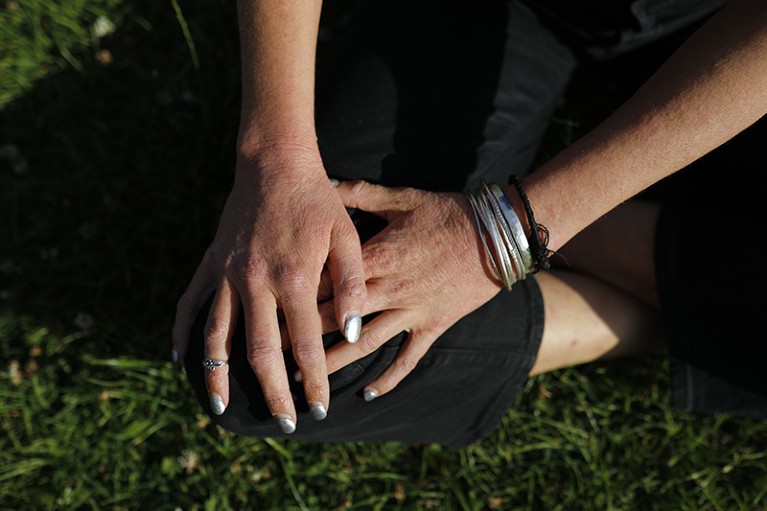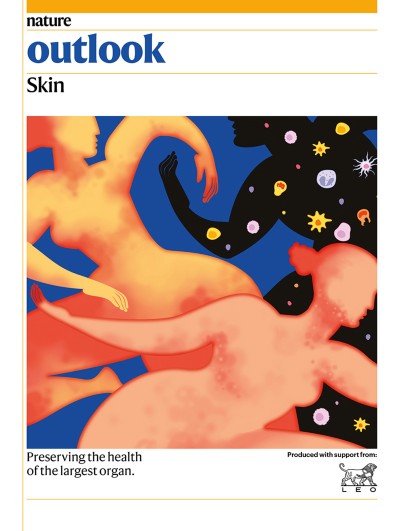
Abigail Stein experienced recurring skin infections when she stopped using steroid creams.Credit: Monika Deupala for Nature
When 28-year-old Abigail Stein from London was prescribed a topical corticosteroid to treat her eczema, she trusted that her skin condition would start to settle. Instead, it erupted. What had begun as a stubborn patch of hand dermatitis spread aggressively across her body. Physicians prescribed stronger and stronger steroid creams, but things only worsened.
Stein has had eczema since she was a child and is used to periods of flare-ups and remission. This was different — she noticed redness in places where she never had before, such as on her arms and belly. “My whole torso was bright red and itchy,” she says. Concerned that the creams might be making things worse, Stein tried to stop using them. But when she did, her skin became so dry that it started to crack. She also experienced stabbing nerve pain and recurring skin infections. Overwhelmed by the acute discomfort, she moved back in with her family and stopped seeing her friends. “I remember wondering, ‘What did I think about before all this?’” she says. “My skin completely consumed me.”
Nature Outlook: Skin
It was on a stranger’s blog that Stein first came across a condition called topical steroid withdrawal (TSW). What she read scared her. “It was terrifying. People were talking about being bedridden for months,” she says. Symptoms include rebound redness between treatment applications and intense burning, itching and stinging. Some people report that when they try to stop using topical steroids, their skin oozes, swells and flakes. In severe cases, individuals develop nerve pain and psychological symptoms, such as suicidal ideation. “I was so shocked that I couldn’t speak,” Stein says. “A few days later, I told my family: ‘I think I have this thing called TSW.’”
Despite cases such as Stein’s, the recognition of TSW as a condition distinct from eczema remains controversial in the field of dermatology. Amy Paller, a dermatologist at Northwestern University Feinberg School of Medicine in Chicago, Illinois, says she has never seen a case of TSW in her clinic. There is no agreed diagnostic criterion, no clarity on its prevalence and no consensus on which patterns of topical corticosteroid use might trigger it. But fresh research is beginning to shed light on a possible biological mechanism for TSW, which could point to treatment clues.
From miracle to mistrust
Topical steroids haven’t always been demonized. In fact, their introduction during the early 1950s, in the form of a cream called compound F, produced miraculous results for people with eczema. In a matter of days, the redness and itchiness disappeared. This topical preparation, which contained the corticosteroid medication hydrocortisone1, is considered to be the most significant landmark in the history of treating skin problems. Topical corticosteroids are generally safe, effective and easy to apply, and therefore are often used as a first-line treatment for dermatitis.
Perhaps that’s why scepticism around TSW prevails in some parts of the dermatology community. “I don’t think TSW is a real condition in most cases,” says Emma Guttman, a dermatologist at the Icahn School of Medicine at Mount Sinai Hospital in New York City. Guttman thinks there’s a simple explanation for TSW: eczema that reoccurs when people stop their treatment prematurely. But some of these individuals should never have been prescribed topical steroids in the first place, she says. “If a patient with extensive disease is given only a topical treatment, it may help in a limited way, but not enough. If you stop the treatment, the disease comes back. But that’s not topical steroid withdrawal; that’s undertreated disease.” Other specialists, including dermatologist Peter Lio at Northwestern University Feinberg School of Medicine, say the clinical picture is distinct. These individuals are flushing, shedding skin like snow and experiencing nerve pain. This isn’t textbook eczema, he says. The official view might be starting to shift: some countries, such as the United Kingdom, now include warnings about TSW on corticosteroid packaging, acknowledging it as a potential risk of prolonged use.
But, because of the lack of clinical consensus, many people such as Stein (whose dermatologists continued to prescribe steroid treatments despite her concerns) report feeling dismissed by health-care professionals, often leading them to seek help from unregulated online sources. Social media has driven the discussion of TSW — #topicalsteroidwithdrawal has racked up hundreds of millions of views on TikTok — and it has also fuelled confusion and fear of evidence-based treatments, say some specialists. Some influencers advocate risky alternatives, including extreme dietary restrictions or even total water avoidance. Others tell followers to stop all topical steroid medication abruptly. “Unstopped, this vicious cycle of misinformation could result in uncontrolled disease and dangerous health effects,” warned a team of dermatologists at South Infirmary Victoria University Hospital, Cork, Ireland, in a 2022 review2.

Topical steroid withdrawal can cause nerve pain as well as intense burning, itching and stinging of the skin.Credit: Monika Deupala for Nature
For Lio, the question is now less about whether TSW exists or not. “I think anyone who says it doesn’t is just being a denialist at this point. The harder question is: what exactly is TSW?” Something distinct is occurring in some people who stop their steroid treatments, says Lio. But we don’t fully understand what it is.
One hypothesis is that TSW happens because of an increase in nitric oxide production when topical steroids are withdrawn. This widens blood vessels, increases blood flow to the skin and causes excessive redness3. Another possible mechanism is that corticosteroids cause thinning of the skin, which allows allergens to penetrate the skin barrier, inducing persistent flare-ups of the original disease4. The use of still more topical steroids to treat flare-ups causes further skin thinning, establishing a vicious cycle. However, work published in February5 led by Ian Myles, an immunologist at the US National Institute of Allergy and Infectious Diseases in Bethesda, Maryland, suggests another biological explanation.
The mitochondrial clue
Myles and his colleagues began by analysing a previous survey of 1,889 adults with severe, eczema-like symptoms6. By separating people into two groups, those who self-identified as having TSW and those who did not, the team identified symptoms that were more common in the TSW group. These included a persistent burning feeling, flushing and difficulty staying at a comfortable temperature. Next, the researchers analysed three groups: 16 people with TSW symptoms; 10 people with eczema but no signs of TSW; and 11 healthy individuals5. They found that compared with the other two groups, people with TSW had elevated levels of nicotinamide adenine dinucleotide (NAD+), a compound derived from vitamin B3 (niacin), in their blood and skin.
In a separate experiment in the study, the researchers applied high-potency topical steroids to the skin of healthy volunteers. In a few hours, says Myles, the volunteers showed increased levels of mitochondrial complex I, an enzyme involved in niacin metabolism. “When you start applying steroids, your body responds by adding more complex I to the mitochondria in the skin,” says Myles. In most people, the activity of steroid-induced mitochondrial complex I tapers off once the treatment ends. “But for TSW patients, it doesn’t,” he says. “It never turns off.” This sustained overactivity leads to chronic accumulation of NAD+. The body responds by breaking down the amino acid tryptophan, Myles explains, leading to neurotoxic metabolites that might underlie TSW’s hallmark symptoms.
One myth that prevails on social media is that if people stop using topical steroids, the condition will resolve itself. “But it’s not that simple,” Lio says. Many of the people with TSW that he sees have already discontinued their steroid treatment, and are still struggling, sometimes years later. “From a pharmacological perspective, that shouldn’t happen. Once a drug is out of your system, it’s gone,” he says. “But these patients have clearly been transformed into something different. So I don’t think the ‘just wait it out’ strategy is viable.”
More from Nature Outlooks
Guttman counters that such symptoms aren’t entirely surprising. Abruptly stopping use of a topical steroid will cause the disease to return. “Patients may interpret that as withdrawal,” she says. “But in my view, they were never treated appropriately in the first place.” However, the NAD+ findings hint at a path forwards. When Myles’ team gave TSW participants drugs that inhibit mitochondrial complex I, such as metformin or berberine, many reported a reduction in symptoms over three to five months. These results suggest that TSW might be pharmacologically reversible5. This approach draws further plausibility from the fact that berberine is the active compound in the traditional Chinese medicine Wu Mei Wan, which has previously been shown to be an effective treatment for TSW7.
Stein stopped all treatment three and a half years ago (neither Lio or Guttman recommend abruptly halting treatment). She now manages her condition with dietary changes, baths and herbal remedies. Once unable to socialize because of her skin, she says her symptoms have markedly improved. But she still lives with the apprehension of a sudden eruption. “In January, my face flared out of nowhere,” she says. “It was so painful I couldn’t eat breakfast.”
Learning to listen
People’s fear of being harmed by the therapies that are meant to help them poses a challenge for clinicians. Topical steroids still play an important part in dermatology, says Lio. But they’re not suitable for everyone, he emphasizes. One approach could be to use topical steroids to rapidly control small, acute flare-ups, then to switch to newer treatments for maintenance. Dermatology’s toolbox is growing, and immune-modulating medications, such as Janus kinase inhibitors and phosphodiesterase-4 inhibitors, as well as biologics (medications derived from living cells), are efficacious alternatives to topical steroids. “It frustrates me when I hear clinicians say, ‘There’s nothing else besides steroids,’” says Lio. “That was true 20 years ago. It’s not true now.”
The debate over whether TSW is real might be fading, but people whose symptoms don’t fit standard eczema patterns still live with the unsettling discomfort. With researchers such as Myles beginning to shed light on possible mechanisms, Lio hopes that the TSW conversation can be moved off online forums and into medical clinics.
The path forwards will require an agreed set of diagnostic criteria and formal training for physicians, so that when people ask about TSW, they’re met not with doubt, but with a therapeutic road map. But the first step, according to Lio, is listening to people’s lived experience. “Regardless of whether we fully understand the mechanism behind their condition, patients are suffering,” he says. “We need to meet them with care and humility.”




